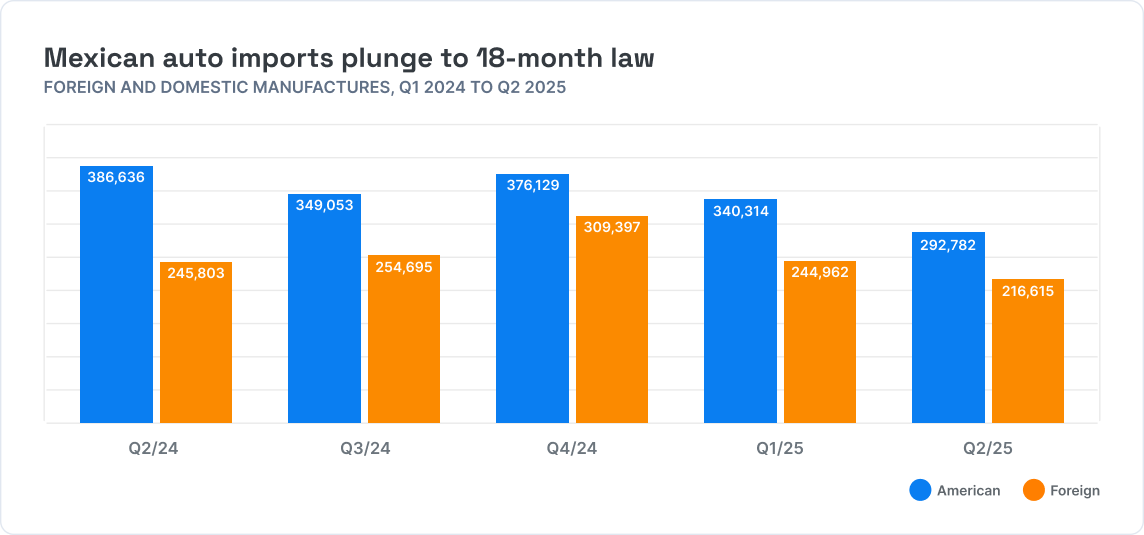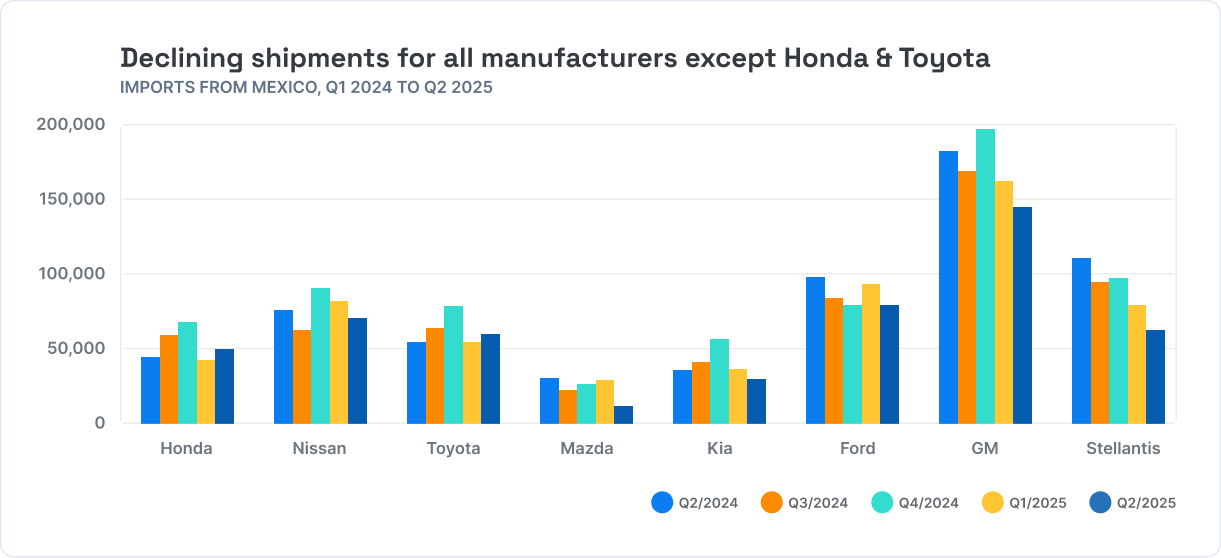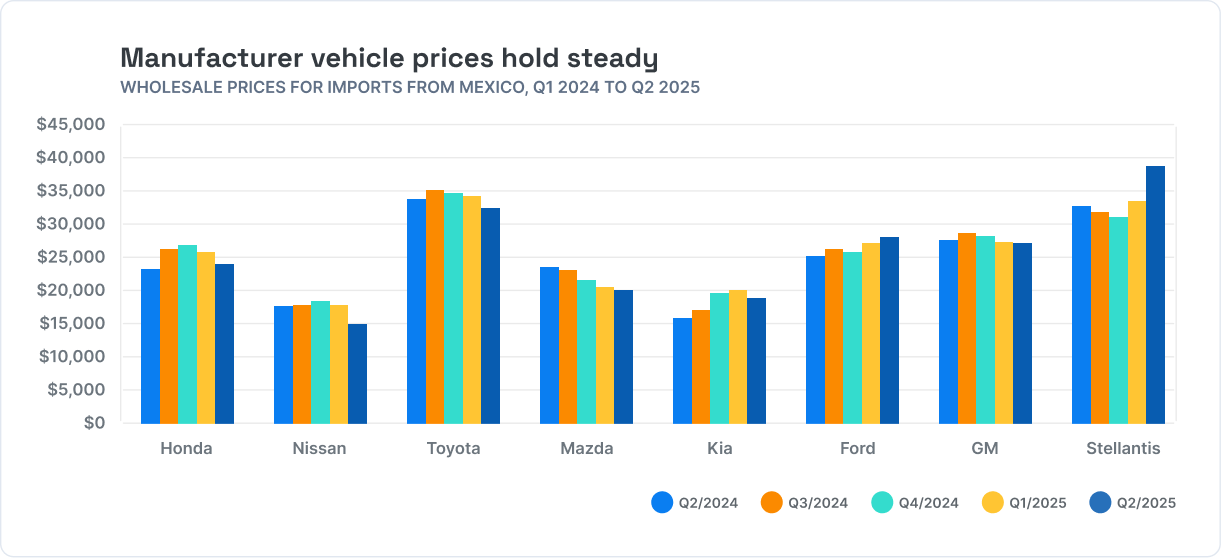Vehicles from Mexico decreased by 13% in the second quarter of 2025, following the imposition of 25% tariffs in early April
What you’ll learn in this article:
- How imports of vehicles from Mexico have declined precipitously for two consecutive quarters.
- How vehicle manufacturers are responding to a new era of increased tariffs and changing global trade patterns.
- Which sectors will be impacted by the new strategies and tactics now being deployed by carmakers.
🎯 Best for: Strategic planning executives across the automotive, steel, and plastics industries.
According to ImportGenius’ trade database, imports of Mexican-made vehicles to the United States dropped 13% from April to June of this year. The decline comes amid the imposition of a 25% tariff on all imported vehicles and auto parts, which took effect on April 3. It’s also the second consecutive double-digit quarterly decline, following on the heels of a 15% decrease from January to March.
The eight largest importers of cars from Mexico (Honda, Mazda, Nissan and Toyota from Japan, Korea’s Kia Motors, and American manufacturers GM, Ford and Stellantis) brought 75,879 fewer cars into the U.S. in Q2 than they did in Q1. Total imports for the quarter, at 509,397 vehicles, are by far the lowest they’ve been in the last 18 months.
“The data shows a strategic shift by both domestic and foreign car manufacturers in response to tariffs,” says ImportGenius founder and CEO Michael Kanko. “With a 25% tariff on every car, automakers are scaling back their import volumes while trying to keep prices in check —changes that will ripple through multiple sectors of the economy.”

Import data: Steep declines for Mazda, Kia, Stellantis
Despite multiple delays and protests from both domestic and foreign automakers, United States President Donald Trump imposed a 25% tariff on all foreign-manufactured vehicles on April 3, following through on policies announced at the start of the year. And that has changed the business landscape for automakers, who continue to adjust to the new normal in global trade.
Only two of the eight automakers in ImportGenius’ analysis, Honda and Toyota, increased their imports from Q1 to Q2. The remaining six automakers all reduced imports, with Mazda (- 65%), Stellantis (-29%) and Kia (-26%) showing the most significant single-quarter declines.

The lower imports are part of the reason behind a decline in total vehicle inventories during the first half of 2025 compared to 2024. The market has also been robust for both new and used vehicles, as buyers sought upgrades before tariff-induced price hikes were expected to kick in.
Tariffs reshape pricing power
Since tariffs now add 25% to the cost of each imported vehicle, manufacturers are facing intense pressure to keep wholesale prices low. The pre-tariff price of imported vehicles for Q2, as listed in shipping manifests analyzed by ImportGenius, largely held the line, staying roughly in line with prices in Q1. Only Stellantis raised its prices from Q1 to Q2 (+14%), while both Honda (-10%) and Nissan (-17%) significantly reduced their prices. Other manufacturers held prices relatively steady.

According to auto industry observers, manufacturers are being more disciplined in their approach to the market by shifting their focus to their most profitable brands. They are also reducing electric vehicle inventories, given that the federal $7,500 tax credit for EVs will expire on September 30.
A tight squeeze for the auto sector, and beyond
With car makers importing significantly fewer vehicles while keeping a lid on prices, it’s bound to have a significant impact on dealers, mechanics, steelmakers and auto parts. Automakers’ supply chains have been beset with challenges in recent years, from the disruptions of the covid-19 pandemic to rising inflation to the trade battle over critical minerals, many of which are essential to vehicle production.”
ImportGenius’ trade database can help any auto-sector supplier map the supply chains for any manufacturer, allowing them keep track of their competitors, source better deals on materials, and identify new sales opportunities. “After two consecutive quarters of steeply declining imports, it’s a much more competitive landscape than it was just a year ago,” Kanko says. “Many will need to fight to maintain market share.”
Since the start of the year, American manufacturers’ imports from Mexico are down 22%, while Japanese and Korean imports are down a full 30%. “New car inventories are down overall, and tariffs are one of the drivers behind that,” says Kanko. “Automakers appear to be testing and adopting new strategies for a new era of tariff-driven trade.”
[CTA]
Find out how tariffs are changing your business

Find out how tariffs are changing your business



More blogs & reports





